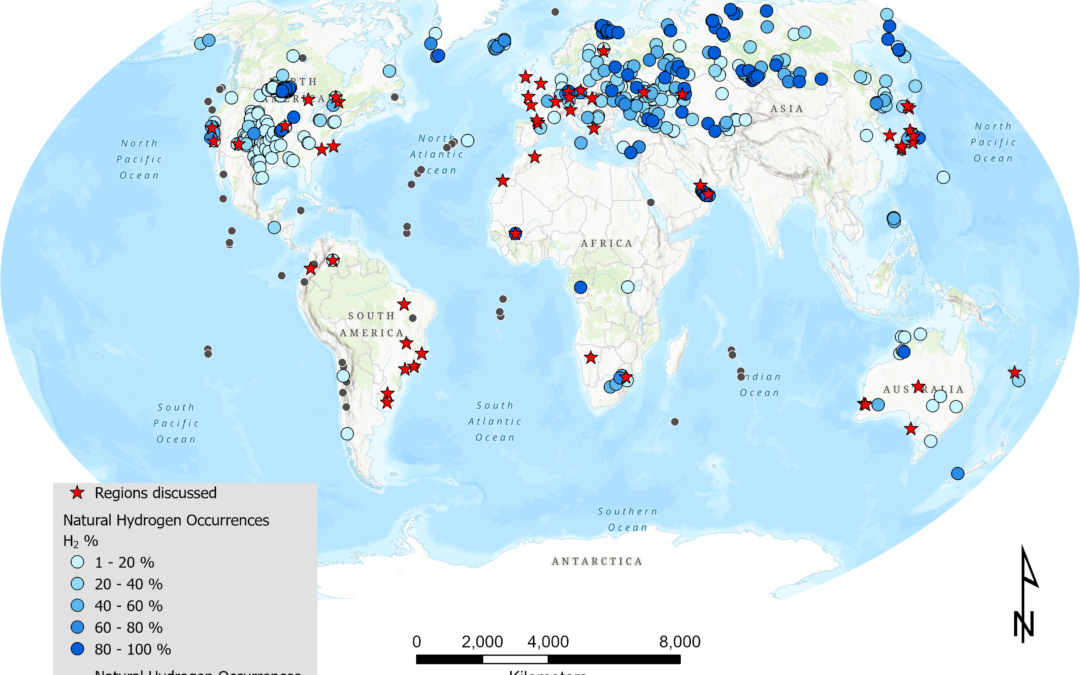By: Eiichi Setoyama, Ph.D., Research Scientist
In the last quarter of 2024 and the first quarter of 2025, I had the privilege of attending the University of Utah & University of Houston joint technical conference, H-NAT 2024, the Surf’Hy symposium organised by USGS and IFPEN, the GeHyGeNet workshop at the Edinburgh Climate Change Institute, and the Natural Hydrogen Workshop in Japan by JOGMEC, JAPT, and NEDO.
Each event attracted unique groups of presenters and attendees, offering a variety of perspectives on natural hydrogen research and commercialisation. H-NAT, being the largest and most international, covered a breadth of topics, including updates from exploration and prospectivity programs in various countries (Figure 1) and panel sessions on finance and regulatory issues. The Surf’Hy symposium focused more on exploration strategies, with emphasis on methodologies for hydrogen seepage monitoring and isotope analyses for source identification.
The GeHyGeNet workshop featured presentations from CO2 and H2 storage experts and panel sessions on commercialisation and global hydrogen generation potential. It also explored topics such as microbial hydrogen metabolism, hydrogen leakage risks, and its environmental impacts. The workshop in Japan opened with keynotes by Geoffrey Ellis (USGS) and Douglas Wicks (ARPA-E), followed by technical presentations and a panel discussion regarding natural hydrogen potential in Japan.
During the UU & UH joint technical conference, we had presentations and a brainstorming session that addressed various aspects of natural hydrogen, including economics and a new multispectral image analysis method to identify natural hydrogen seeps.
At H-NAT, over 30 exhibitors showcased cutting-edge equipment, software, and consulting services for natural hydrogen exploration. Following the event, Vinci Technologies kindly gave me a tour of their labs, where I had an opportunity to see HNAT-Eval in operation and a core flooding system ready for hydrogen experiments. Both are bespoke adaptations of equipment widely used in petroleum exploration for natural hydrogen exploration workflows.
The five events provided me with valuable opportunities to network and share ideas with new and familiar acquittances and keep myself up-to-date with the rapid developments happening around the globe. Here are five of my key takeaways from the conferences and workshops:
1) The published information and the presentations from the conferences and workshops (Figure 1) indicate many studies and exploration programs have been dictated by the availability of existing data, such as gas composition data from vintage well reports and sub-circular depressions. Prospectivity/favourability mapping, which integrates subsurface geology (e.g., Gelman et al., 2025, USGS Professional Papers) and the application of remote sensing technology, may shed light on prospects in unexplored areas for further study.
1)Lab experiments and basin-scale modelling in various studies demonstrated that water movement is crucial for the generation, migration, and accumulation of natural hydrogen at the molecular to basin scales.
1)Equipment and software for characterisation and modelling of the components and processes of natural hydrogen systems are rapidly becoming available.
1) Globally, there are now more than 100 natural hydrogen-related companies (Wicks, 2025, Natural Hydrogen Workshop in Japan). While all the events gathered attendees from both the industry and academia, my impression is that there is more enthusiasm in the industry than in academia, indicating room for closer industrial–academic cooperation.
1) Successful exploration and exploitation of natural hydrogen require a team of experts from various fields, including oil & gas, porous media storage (CO2, CH4, and H2), geothermal energy, hydrogeology, mining, microbiology, and remote sensing. By combining our knowledge and experience, we can expedite natural hydrogen research and exploration, generating more data and information to deepen our understanding of the complex systems, and the technical and commercial feasibility of natural hydrogen exploitation can finally be assessed based on much-desired production data from large-scale commercial projects.
Most of the research and exploration programmes were in progress at the time of the events. We can expect substantial results and exciting developments in natural hydrogen research in the coming months.
A story map by the EGI research team above has been made available.
If you are interested in learning about the Natural Hydrogen Knowledge Platform, please contact the project team.
Eiichi Setoyama (esetoyama@egi.utah.edu)
Bryony Richards (brichards@egi.utah.edu)
Christopher Kesler (ckesler@egi.utah.edu)

